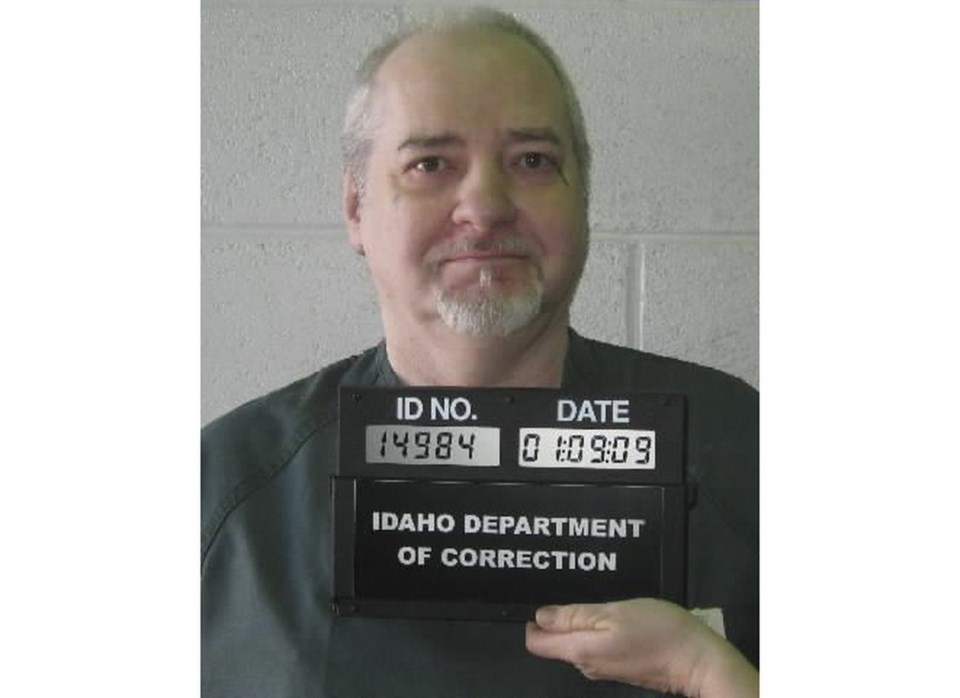BOISE, Idaho (AP) — Idaho prison officials will attempt to execute the state’s longest-serving death row inmate next month using new protocols after botching the first attempt several months ago.
A judge issued a death warrant for Thomas Eugene Creech Wednesday morning, one day after the Idaho Department of Correction announced it had renovated its execution chamber to allow the execution team to insert catheters deep into the neck, groin, chest or arms of inmates if they are unable to establish a standard peripheral intravenous line.
The change came after the state tried and failed to execute Creech in February. Execution team members tried eight locations in Creech’s arms and legs but could not find a viable vein to deliver the lethal drug. The new death warrant says Creech will be executed at 10 a.m. on Nov. 13.
Robin M. Maher, executive director of the Death Penalty Information Center, said that as far as is known, Idaho would be the first state to try to execute someone a second time using the same method tried during an earlier botched attempt. She noted that two Alabama inmates — Kenneth Smith and Alan Miller — were executed this year after prior failed attempts, but in both cases, the second try used a different method: nitrogen gas.
“Any time there is a botched execution and the public are not given a full and meaningful understanding of what went wrong, it prompts additional concerns,” she said. “We know Mr. Creech’s execution failed because the execution team could not access a vein, but we have not received any complete information from the Department of Correction about why that happened or what steps have been taken to prevent a similar mistake from happening in the future. Instead, we see them pivoting to a new method of accessing a vein.”
Creech’s attorneys with the Federal Defender Services of Idaho said the state was “sacrificing common decency and humanity” in its haste to try again to kill him.
“We are heartbroken and angered that Idaho would try again to execute Thomas Creech using virtually the same process and team and executioners, and before conducting any official review of what led to the botched attempt to take his life earlier this year,” the defense team wrote in a press release. “The level of recklessness puts Idaho in a class by itself, as other states that botched executions took significant steps to examine what went wrong before trying again.”
Creech, 74, has been in prison half a century, convicted of five murders in three states and suspected of several more. He was already serving a life term when he beat a fellow inmate, 22-year-old David Dale Jensen, to death in 1981 — the crime for which he was to be executed.
In the decades since, Creech has become known inside the walls of the Idaho Maximum Security Institution as just “Tom,” a man who occasionally writes poetry and is generally considered well-behaved. His bid for clemency before the last execution attempt found support from a former warden at the penitentiary, prison staffers who recounted how he wrote them poems of support or condolence and the judge who sentenced Creech to death.
The Idaho Department of Correction announced Tuesday it had renovated the execution chamber facility to allow execution team members to insert central venous lines in condemned inmates if a peripheral IV can't be established. Establishing a central line is a more complex procedure that requires more training, and is typically completed by an anesthesiologist, doctor or other medical professional with special training.
In a central line procedure, a physician typically decides whether to use the jugular vein in the neck, the femoral vein in the groin, or other large veins near the collarbone or in the upper arm. They numb the area using a local anesthetic before using a needle to insert a guidewire into the large vein. The soft tissue surrounding the puncture site is then widened using a scalpel and dilation tool before the catheter is threaded over the guidewire. Once the catheter is inside the vein, it is guided to a location just outside the heart with the help of an ultrasound machine.
Signs that a central line is improperly inserted could include bright red bleeding from the puncture site or a change in the patient's vital signs.
If the scheduled execution moves forward, it will be Idaho’s fifth such effort since capital punishment resumed in 1976. Keith Eugene Wells was executed by lethal injection in 1994 after giving up his appeals and asking to be put to death. Paul Ezra Rhoades was executed in 2011, and Richard Albert Leavitt was executed in 2012.
___ Associated Press reporter Gene Johnson contributed from Seattle.
Rebecca Boone, The Associated Press

